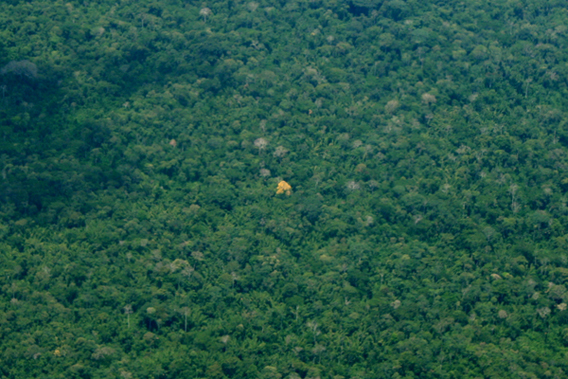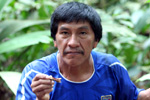
A single tree blooms in the Amazonian canopy of Yasuni National Park. Photo by: Jeremy Hance .
The discovery of a new plant species is not uncommon, especially in places of remarkable biodiversity such as the Amazon rainforest. However, discovering a new plant genus, a taxonomic rank above species, is, according to Henk van der Werff fromt the Missouri Botanical Garden (MBG), “a matter of luck and perseverance”. Researchers with the Missouri Botanical Garden have been blessed with both as they have announced two new species of Amazonian plants, one from Ecuador and one from Peru, that comprise a completely new genus: named, Yasunia, since the plant was originally discovered in Ecuador’s vast Yasuni National Park.
“There are many new species found mostly in the tropics each year. Typically, new species differ in minor characteristics from their close relatives. New genera differ in major characteristics from their relatives,” explains Van der Werff, who heads the MBG’s Monographic Studies Department.
Researchers from MBG’s staff first collected the new genus in 1993 in Yasuni National Park. Later staff in the park collected more specimens for identification. Scientists were then able to determine that the new species was not similar to any genus in the Laurel family. Another unique species of this new genus was collected in 2003 in Peru’s upper Rio Utiquinia in Ucayali.
“This is an extremely rare and exciting scenario […] Usually, when a new genus is discovered, it is associated with only one species. It is very unusual to find two new species belonging to the same new genus. Yasunia with two new species is one of those very rare cases,” said Van der Werff.
Ecuador’s Yasuni National Park has been dubbed by some tropical researchers as the most biodiverse place in the world, i.e. containing more species than anywhere else. According to one study more trees grow in a single hectare (2.47 acres) of upland rainforest in Yasuni—655 species—than in the continental US and Canada combined. However, the park’s species and indigenous groups are threatened by ongoing oil exploration and drilling.
Related articles
Oil, indigenous people, and Ecuador’s big idea
 (11/23/2010) Ecuador’s big idea—potentially Earth-rattling—goes something like this: the international community pays the small South American nation not to drill for nearly a billion barrels of oil in a massive block of Yasuni National Park. While Ecuador receives hundred of millions in an UN-backed fund, what does the international community receive? Arguably the world’s most biodiverse rainforest is saved from oil extraction, two indigenous tribes’ requests to be left uncontacted are respected, and some 400 million metric tons of CO2 is not emitted from burning the oil. In other words, the international community is being asked to put money where its mouth is on climate change, indigenous rights, and biodiversity loss. David Romo Vallejo, professor at the University of San Francisco Quito and co-director of Tiputini research station in Yasuni, recently told mongabay.com in an interview that this is “the best proposal so far made to ensure the protection of this incredible site.”
(11/23/2010) Ecuador’s big idea—potentially Earth-rattling—goes something like this: the international community pays the small South American nation not to drill for nearly a billion barrels of oil in a massive block of Yasuni National Park. While Ecuador receives hundred of millions in an UN-backed fund, what does the international community receive? Arguably the world’s most biodiverse rainforest is saved from oil extraction, two indigenous tribes’ requests to be left uncontacted are respected, and some 400 million metric tons of CO2 is not emitted from burning the oil. In other words, the international community is being asked to put money where its mouth is on climate change, indigenous rights, and biodiversity loss. David Romo Vallejo, professor at the University of San Francisco Quito and co-director of Tiputini research station in Yasuni, recently told mongabay.com in an interview that this is “the best proposal so far made to ensure the protection of this incredible site.”
Photos: park in Ecuador likely contains world’s highest biodiversity, but threatened by oil
 (01/19/2010) In the midst of a seesaw political battle to save Yasuni National Park from oil developers, scientists have announced that this park in Ecuador houses more species than anywhere else in South America—and maybe the world. “Yasuní is at the center of a small zone where South America’s amphibians, birds, mammals, and vascular plants all reach maximum diversity,” Dr. Clinton Jenkins of the University of Maryland said in a press release. “We dubbed this area the ‘quadruple richness center.'”
(01/19/2010) In the midst of a seesaw political battle to save Yasuni National Park from oil developers, scientists have announced that this park in Ecuador houses more species than anywhere else in South America—and maybe the world. “Yasuní is at the center of a small zone where South America’s amphibians, birds, mammals, and vascular plants all reach maximum diversity,” Dr. Clinton Jenkins of the University of Maryland said in a press release. “We dubbed this area the ‘quadruple richness center.'”
World’s smallest orchid discovered in Ecuador
(11/30/2009) Measuring just 2.1 millimeters wide, the world’s smallest orchid has been discovered hiding in the roots of another plant, reports the Independent.